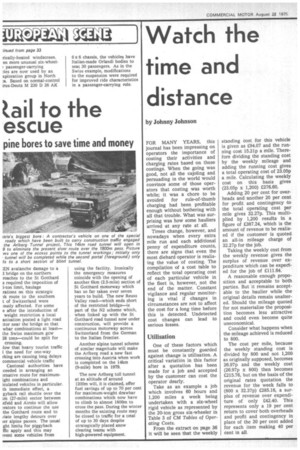Watch the time and distance
Page 36

If you've noticed an error in this article please click here to report it so we can fix it.
by Johnny Johnson
FOR MANY YEARS, this journal has been impressing on operators the importance .of costing their activities and charging rates based on those costings. When the going was good, not all the cajoling and persuading in the world would convince some of those operators that costing was worth while; it was a chore to be avoided for rule-of-thumb charging had been profitable enough without bothering with all that .trouble. What was surprising was how some hauliers arrived at any rate at all.
Times change, however, and nowadays when every extra mile run and each additional penny of expenditure counts, there are signs that even the most diehard 'operator is realising the value of costing. The compilation of a cost table to reflect the total operating cost of each particular vehicle in the fleet is, however, not the end of the matter. Constant vigilance and regular monitoring is vital if changes in circumstances are not to affect the cost for a long time before this is detected. Undetected cost changes can lead to serious losses.
Utilisation
One of these factors which must be constantly guarded against change is utilisation. A critical variation in this fadtor after a quotation has been made for a job and accepted by the customer can cost the operator dearly.
Take as an example a job which involves 60 hours and 1.200 miles a week being undertaken with a six-wheel rigid vehicle as represented by the 20-ton gross six-wheeler in Table 3 of CM Tables of Operating Costs.
From the extract on page 36 it will be seen that the weekly standing aost for this vehicle is given as £94.07 and the running cost 15.21p a mile. Therefore dividing the standing cost by the weekly mileage and adding the running cost gives a total operating cost of 23.05p a mile. Calculating the weekly cost on this basis gives (23.05p x 1,200) £276.60.
Adding 20 per cent for overheads and another 20 per cent for profit and contingency to the total operating cost per mile gives 32.27p. This multiplied by 1,200 results in a figure of £387.24, which is the amount of revenue to be realised if the customer is quoted an all-in mileage charge of 32.27p for the job.
Taking the weekly cost from the weekly revenue gives the surplus of revenue over expenditure which can be expected for the job of £111.64.
A reasonable enough proposition and acceptable to both parties. But it remains acceptable to the haulier while the original details remain unaltered. Should the mileage quoted for not materialise the proposition becomes less attractive and could even become quite uneconomical.
Consider what happens when the mileage achieved is reduced to 800.
The cost per mile, because the weekly standing cost is divided by 800 and not 1,200 as originally supposed, becomes 26.97p and the weekly cost (26.97p x 800) then becomes £215.76, but on the basis of the original rates quotation the revenue for the week falls to (800 x 32,37p) £285.16, a surplus of revenue over expenditure of only £42.40. This represents only a 19 per cent return to cover both overheads and profit and contingency in place of the 20 per cent added for each item making 40 per cent in all.












































































